Seminole Wars Authority
The Seminole Wars Authority podcast looks at Seminole resistance to the United States’ campaign of Indian removal in the 1800s. We explore what the Seminole Wars were, how they came to be, how they were fought, and how they still resonate some two centuries later. We talk with historians, archaeologists, anthropologists, archivists, writers, novelists, artists, musicians, exhibitors, craftsmen, educations, park rangers, military-era reenactors, living historians, and, to the descendants of the Florida and Oklahoma Seminole who fought tenaciously to avoid US government forced removal. Host Patrick Swan is a board member with the Seminole Wars Foundation. This podcast is recorded at the homestead of the Seminole Wars Foundation -- www.seminolewars.us -- in Bushnell, Fla. Subscribe automatically to the Seminole Wars Authority through your favorite podcast catcher. (Banner photo by Andrew Foster)
Episodes
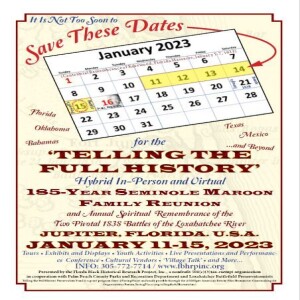
Sunday Dec 18, 2022
Sunday Dec 18, 2022
The Seminole Maroon diaspora returns to Jupiter, Florida in January for a family reunion January 11 to 15.
To bring them together, the Florida Black Historical Research Project, Inc accepted a federal grant – “Telling the Full History”. Attendees hail from within Florida, but also from Oklahoma, Texas, Mexico, The Bahamas, and Trinidad.
They will take a day-long bus tour of South Florida sites that reference and/or honor Seminole Maroon history and listen to a day of presentations featuring history and life of Seminole Maroons in the Western Hemisphere.
They will also screen a film, The story of the Seminole Negro Indian Scouts of Texas.
Attendees will hear oral histories of Seminole Maroon history and autobiographical and personal stories of descendants. They will cap off their visit with a spiritual remembrance, featuring sacred presentations by various religious faiths to honor the fallen on both sides—the U.S. military and the Seminole-Seminole Maroon warriors and family members.
One can learn more by visiting this website:
https://flblackhistoricalresearchproject.org/
Joining us to fill in the details for this, yes, historic assembly are organizers Wallis and Gene Tinnie.
Dr. Wallis Hamm Tinnie is President of Florida Black Historical Research Project, Inc., an organization founded by her cousin, the late Isa Hamm Bryant. Isa, a Seminole Maroon descendant, was one of the driving forces behind the reclamation of Loxahatchee River Park as a battlefield site. Dr. Tinnie is the granddaughter of the late Seminole descendant Florence Ealer Jones Hamm. Florence left her native home in the village of Mikasuki on the edge of Tallahassee, Florida. Dr. Tinnie has worked diligently for the last 15 years to continue the work of honoring the sacred site of her ancestors in and around Loxahatchee River Battlefield Park.
Gene Tinnie is a retired educator as well. Gene, a Fulbright scholar, is an activist in historical preservation and cultural affairs. He has an academic background in foreign languages, linguistics, and literature. He is founder and co-director of the Dos Amigos/Fair Rosamond Middle Passage Ship Replication Project. Among the many boards on which he sits is the historic Loxahatchee Seminole Maroon Battlefield in Palm Beach County.
Dr. Wallis Tinnie and her husband Gene with Seminole Nation Chief Lewis Johnson and his security aide in 2022 at the Convocation of Seminole War Historians at Loxahatchee River Battlefield State Park.
The Mission of the Florida Black Historical Research Project Inc is to research, collect, and disseminate knowledge of significant contributions Blacks have made in the State of Florida.
Host Patrick Swan is a board member with the Seminole Wars Foundation. This podcast is recorded at the homestead of the Seminole Wars Foundation in Bushnell, Fla.
Subscribe automatically to the Seminole Wars through your favorite podcast catcher and "like" us on Facebook, LinkedIn, and YouTube!
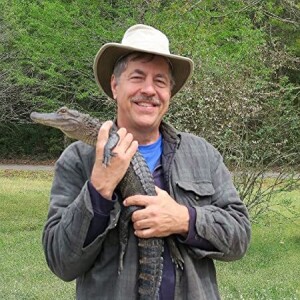
Sunday Dec 11, 2022
Sunday Dec 11, 2022
The US Government spent millions of dollars and incurred thousands of casualties attempting to remove the Seminole from Florida in the first half of the 1800s. Today, the Seminole are still here – and they are thriving; they are integral to a study of Florida’s history.
And they are the subject of fascination in popular culture. A 1950s Greyhound busline booklet features iconic sites to visit around the United States. For Florida, that meant no Disney park – had not been built yet; no NASA space center– again, not built yet. THE tourist attraction of Florida were the Seminole!
Doug Alderson returns to discuss how he presents the Seminole in his books, one of which is on such old Florida attractions. Seminole are also portrayed in vintage art around the Sunshine State, and no study of American alligators is complete without an exploration of Seminole wrestling of the ancient creatures. Doug even explores the Seminole in spooky ghost stories. Topping it off is his compelling historical novel, Seminole Freedom. It traces the tale of a self-liberated black teen and her adventures and contacts in the first two Seminole wars. We will discuss all this and more with Doug.
Greyhound Buslines featured Seminole as the Florida attraction in the 1950s.
Host Patrick Swan is a board member with the Seminole Wars Foundation. This podcast is recorded at the homestead of the Seminole Wars Foundation in Bushnell, Fla.
Subscribe automatically to the Seminole Wars through your favorite podcast catcher and "like" us on Facebook, LinkedIn, and YouTube!

Sunday Dec 04, 2022
Sunday Dec 04, 2022
There is fresh blood in the living history community for the Seminole Wars. Two reenactors, Stephen and Paulette Dennis, entered the hobby in November at Florida Heritage Day at Dade Battlefield Historic State Park in Bushnell, Florida.
When we say “fresh blood”, we are somewhat facetious. Stephen retired from the U.S. Navy after a quarter century and Paulette kept the home fires burning at the Dennis house. What they don’t have in youth, they make up for with experience, knowledge, and a Florida heritage.
Stephen dresses as an Army private of the 1830s, along with his wife, Paulette who takes on the appearance of an 1830s Pioneer matriarch. The Dennis’ display the rations that Soldiers would have eaten on the march. They assiduously followed the recipe compiled by our own Jerry Morris, who penned a short booklet, An Army Moves on Its Stomach, for the Seminole Wars Foundation some years back.
Stephen and Paulette have tailored their interpretation based on their own ancestors who fought in the Seminole Wars.
Stephen joins us today to share what he knows about all this.
Above, Stephen and Paulette Dennis in 1830s period attire kneaded and baked regulation-specific hard bread of the type that soldiers carried on the march. Below, Matt Milne and Stephen Dennis presented at 1830s Soldiers for Florida Heritage Day at the Dade Battlefield Historic State Park in November, 2022. Here, they convince two wary visitors, Molly and Iris Eldridge, into trying a sample. Moments before, the two Bushnell sisters had received red ochre Seminole facial war paint from Gunpowder Warrior (Steve Creamer). The presentation table of ingredients is based on Jerry Morris' booklet, An Army Moves on Its Stomach, a Seminole Wars Foundation publication.
Stephen did not warn them about potentially losing any teeth. Oops.
Host Patrick Swan is a board member with the Seminole Wars Foundation. This podcast is recorded at the homestead of the Seminole Wars Foundation in Bushnell, Fla.
Subscribe automatically to the Seminole Wars through your favorite podcast catcher and "like" us on Facebook, LinkedIn, and YouTube!

Friday Nov 25, 2022
SW0136 Nicoll’s Outpost Yields War Site Clues to First Seminole War
Friday Nov 25, 2022
Friday Nov 25, 2022
We have devoted several episodes in our podcast the Fort at Prospect Bluff, known best as the “Negro Fort” on the Apalachicola River in Florida’s panhandle. During the War of 1812, the British also built a smaller fort, which historians dub Nicolls’ Outpost. They and their Seminole allies used this as a base to conduct offensive operations into Georgia and Alabama during that conflict. Seminole Indians later used it to stage attacks on the US Army in the First Seminole War. And Historian Dale Cox is here to tell us all about it. His new, hardback edition of Nicoll's Outpost, is expanded from the softcover, with additional chapters and revised content. It is now available from booksellers.
Map sketches of vicinity in 1815 and 1817
Painting of British Royal Marine Edward Nicolls, whose name became permanently associated with the outpost when historian Mark Boyd tagged it as Nicolls' Outpost in the 1950s.
Host Patrick Swan is a board member with the Seminole Wars Foundation. This podcast is recorded at the homestead of the Seminole Wars Foundation in Bushnell, Fla.
Subscribe automatically to the Seminole Wars through your favorite podcast catcher and "like" us on Facebook, LinkedIn, and YouTube!

Saturday Nov 19, 2022
SW0135 Longtime Reenactor Shares Trade Knowledge for Accurate SW Presentations
Saturday Nov 19, 2022
Saturday Nov 19, 2022
Listeners to our last podcast enjoyed a discussion about 19th Century Seminole Men’s Clothing – and what an enterprise it is to recreate them. Unfortunately, the 1991 spiral-bound book is out of print and hard to obtain.
That is, until now.
Enter living history enthusiast and researcher James Flaherty. Jim is a friend of the key individuals behind the Seminole Men’s clothing book – Rick Obermeyer and Pete Thompson.
He has attended and participated in various Seminole War reenactments and events since the 1980s. Jim is also an artisan who hand crafts period accoutrements, leather items and clothing.
Hence, Jim’s new book is Seminole Wars-era Clothing. He and fellow historical enthusiasts penned entries featuring everything one needs to know about crafting period-appropriate clothing. This includes Seminole men and women; American civilian men and women; and military service members from the U.S. Army, U.S. Navy, and U.S. Marine Corps.
Jim tells why he wrote this book and why this book needed to be written. He dedicates it to living history reenactors, hobbyists, and students of the trade. But any general reader will find it fascinating how he takes one on a journey from written accounts and painted images to obtaining materials and piecing together the clothing items one by one.
Jim Flaherty is a member of the Loxahatchee Battlefield Preservationists, the Seminole Wars Foundation, the Dade Battlefield Society, and the Morse Telegraph Club. Image captures are below.
Host Patrick Swan is a board member with the Seminole Wars Foundation. This podcast is recorded at the homestead of the Seminole Wars Foundation in Bushnell, Fla.
Subscribe automatically to the Seminole Wars through your favorite podcast catcher and "like" us on Facebook, LinkedIn, and YouTube!
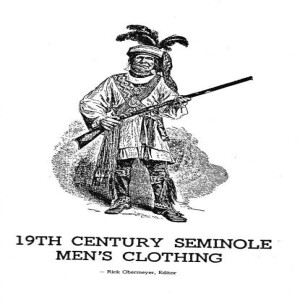
Sunday Nov 13, 2022
Sunday Nov 13, 2022
When you see someone portraying a Seminole in a battle reenactment today, you can pretty much rest assured that the attire is authentic if not original. This was not the case 30 and 40 years ago. Many had good intentions but simply got the clothing wrong. Enter Seminole reenactor Rick Obermeyer. He took both an interest and launched a campaign to portray 19th century Seminole Men’s Clothing as accurately as feasible. He published selections from the top craftsman in the field for such items in 1991. It has served as handbook for Seminole reenactors ever since. Although Rick had no special academic training for the task, he did have a passionate desire to portray Seminole warriors as they presented themselves back then. Listen now as he details just how he assembled that knowledge into a simple manual of instruction.
Getting Seminole plumes and feathers right was possible because the Army acquired specimens not long after the Dade Battle. Photos courtesy Rick Obermeyer.
Although the handbook is hard to find and even then re-selling for $150 in paper copy form, the good people at Nativetech.com took Rick's book and published it in whole on line! See below.
Host Patrick Swan is a board member with the Seminole Wars Foundation. This podcast is recorded at the homestead of the Seminole Wars Foundation in Bushnell, Fla.
Subscribe automatically to the Seminole Wars through your favorite podcast catcher and "like" us on Facebook, LinkedIn, and YouTube!
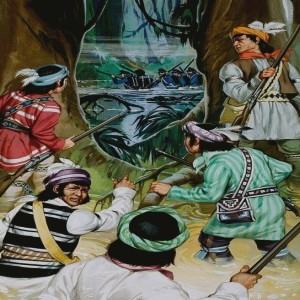
Sunday Nov 06, 2022
Sunday Nov 06, 2022
SW0133 Soldiers Adapted and Innovated Amidst A Climate of Hostility in Florida
In the Second Seminole War, probably every soldier complained about the hostile Florida climate. But, only a few ever did anything about it.
In this episode, Professor Jacob Hagstrom of The Citadel joins us to discuss the climate of operations for soldiers in that war. Jacob examines and assesses disputed overall casualties; whether the climate was uniquely inhospitable; whether it was indeed so hostile that the Army could not successfully remove the Seminole from Florida; and how soldiers -- and Seminole -- adapted and innovated within its confines.
To increase soldier mobility or to slow down Seminole escape, Gabriel Rains fashioned land mines. John Lane fashioned rubber pontoon bridges so soldiers could more easily cross streams and rivers. And Hezekiah Thistle crafted a saddle that could aid evacuation of casualties who would ride “comfortably” in the prone position.
This culture of innovation became so well known that it reached the consciousness of one Edgar Allen Poe, late of the US Military Academy at West Point, who penned a satirical account, The Man That Was Used Up, about service in Florida at the time.
The Seminoles, for their part, innovated as well, switching from labor-intensive log cabins to easily constructed chickees. And they modified their diets to adapt to available produce in the Everglades. They also used the environment to take cover and to conceal themselves from advancing soldiers.
Take a listen to learn how this all panned out.
Seminole adapted to their new south Florida Everglades climate.
Hezekiah Thistle improvised a litter that could be attached to a horse's back for medical evacuation of casualties.
John Lane's rubber bridge pontoons increased the Army's mobility and saw later use in the US-Mexican War and the U.S. Civil War (above). (Below) Edgar Allen Poe wrote a satire on the Army's war innovation. Jacob Hagstrom summed it all up in Florida Historical Quarterly.
Host Patrick Swan is a board member with the Seminole Wars Foundation. This podcast is recorded at the homestead of the Seminole Wars Foundation in Bushnell, Fla.
Subscribe automatically to the Seminole Wars through your favorite podcast catcher and "like" us on Facebook, LinkedIn, and YouTube!
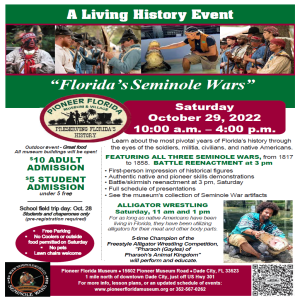
Friday Oct 28, 2022
SW0132 Three Seminole Wars Told at Florida Pioneer Museum Event Oct. 29
Friday Oct 28, 2022
Friday Oct 28, 2022
This week, Andy Warrener returns to discuss the Seminole War-themed Saturday living history event -- Oct. 29 -- at the Florida Pioneer Museum and Village in Dade City, Pasco County, Florida. Besides presenters discussing and sharing anecdotes from all three Seminole Wars, an afternoon battle skirmish is set featuring pioneers, Florida Territorial Militia, Regular Army soldiers, and Seminole Indians. All will be available throughout the day prior to this battle to explain and show how they lived in the 1830s. In addition, five-time champion alligator wrestler Pharoah Gayles makes his first appearance off a Seminole Reservation to display his skills and to teach about the environment that alligators and Seminole have occupied together. Artist Terry Smith presents on The Real Florida as portrayed with nature and Seminole in his paintings.
Host Patrick Swan is a board member with the Seminole Wars Foundation. This podcast is recorded at the homestead of the Seminole Wars Foundation in Bushnell, Fla.
Subscribe automatically to the Seminole Wars through your favorite podcast catcher and "like" us on Facebook, LinkedIn, and YouTube!
See full schedule below images.
Oct. 29, 2022: Living History - Seminole War, 10am.- 4 pm.
Schedule of Events: Florida’s Seminole Wars
10:00am – Event begins
11:00am – Opening remarks, introduction to Seminole history and alligator wrestling
11:10am - Alligator wrestling with Pharaoh Gayles
12:00pm – Indigenous Peoples presentation by Jim Sawgrass
1:00pm – Alligator wrestling with Pharaoh Gayles
1:30pm – (gazebo) Presentation on Seminole canoe building and culture by Daniel Tommie
1:45pm – (gazebo) Presentation on black Seminole history by Matt Griffin
2:00pm - Indigenous Peoples presentation by Jim Sawgrass
2:15pm - (gazebo) early 19th Century Florida and native history by James Bullock with special call-in guest Dale Cox to discuss a recent archeological discovery at the Prospect Bluff or Negro Fort site on the Apalachicola River
3:00pm – Battle/skirmish reenactment
4:00pm – Event ends
The Museum Concession Stand will be open with Burgers, Hotdogs and more. Also, other vendors
CASH ONLY
Alligator Wrestling 11 am and 1 pm (Video)
"Pharaoh (Gayles) of Pharaoh's Animal Kingdom"
https://www.pharaohgayles.com/pharaohs-wildlife-kingdom
Pharaoh Gayles is a professional wildlife handler, educator and conservationist, a performer, and an artist. Pharaoh is a Florida Fish and Wildlife Conservation Commission-licensed handler who loves to pass on his knowledge and expertise. Pharaoh is a five-time Freestyle Alligator Wrestling Competition champion. The only five-time champion in the history of the competition. Pharaoh has appeared on national television programs, including Animal Planet’s “Gator Boys,” and was a featured performer on FOX’s “Game of Talents.”
THE SHOW AND HISTORY: For as long as native Americans have been living in Florida, they have been utilizing alligators for their meat and other body parts. In the early 1900's when tourism started to explode in Florida there were more people witnessing native Americans jumping in the water and catching alligators. Spectators called this alligator wrestling. It is a barehanded capture technique developed by the Native American people as well as other handlers to bring an alligator back home alive. You always wanted to bring the alligator back alive because the meat would spoil very quickly in the Florida Sun. As time went on spectators would pay to see native Americans handle alligators and learn more about the culture. This became one of the 1st forms of revenue for the native people in Florida. The name alligator wrestling is a name that has always stuck, it draws people in from all over the country to observe. The alligators in the demonstrations you see are ALL RESCUED alligators that will be able to live out the rest of their lives in a sanctuary instead of being put down.
Battle Reenactment 3 pm Lawn Chairs welcome
Terry Smith, local artist, will be doing a demonstration in the Lockey Room, in the main Building, during the Saturday event.
Recent Awards
2021 Florida Wildflower Studio, Frostproof, FL – 2nd Place Acrylic
2020 Art in the Park, Brooksville, FL – First Place in Fine Arts
2019 Lutz Art Festival, Lutz, FL-Best of Show and First Place Painting
"My goal is to paint as much of “The Real Florida” as I can. Future generations need to see what has been and is being lost. There is a need to encourage others to speak up to protect our most valuable treasure. Many things in life can be replaced or rebuilt, but not our greatest possession. It is my hope that by recording the natural Florida now, people will realize the importance of saving Florida’s natural resources, to avoid being left with just memories." – Terry Smith
Fliers for upcoming events mentioned in the podcast
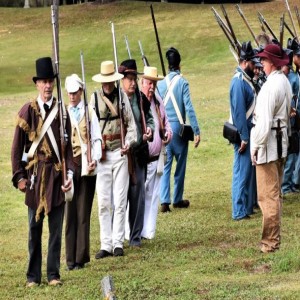
Saturday Oct 22, 2022
Saturday Oct 22, 2022
SW0131 How Well Regulated Must a Militia Be to Ensure Security of a Free State...or Florida Territory?
In our eighth installment in Martial Matters of the Seminole Wars, Jesse Marshall returns one more time. He explains in detail one more aspect of the 2nd Amendment: the purpose of a militia being “well regulated” and what exactly “well regulated” entails at the federal, state, and individual levels. How did this "regulation" ensure a capable militia could muster to defend the security of the free Florida territory during operations to remove Seminole from the peninsula. Jesse Marshall spells it out.
Living history interpreters portray Florida militia assembled for duty for territorial defense during the Seminole Wars, at Florida Pioneer Museum in Dade City. (Below) The militia would form and often assemble next to active duty "regular" troops. (Photos by Andrew Foster)
Militia mustered with and without uniforms -- and with and without fire arms. Jesse Marshall, as a living history interpreter, conducts an inspection of some citizen soldiers assembled at Founder's Day November 2021 at the Dade Battlefield Historic State Park. Below are some firearms they might have mustered with in the Florida Territory.
Host Patrick Swan is a board member with the Seminole Wars Foundation. This podcast is recorded at the homestead of the Seminole Wars Foundation in Bushnell, Fla.
Subscribe automatically to the Seminole Wars through your favorite podcast catcher and "like" us on Facebook, LinkedIn, and YouTube!
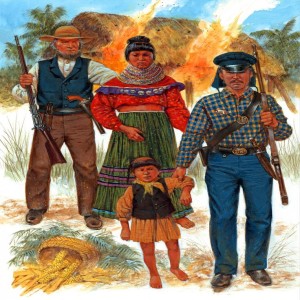
Sunday Oct 16, 2022
Sunday Oct 16, 2022
SW0130 Martial Matters 7: Army Uses Duplicity, Settlers to Subdue Seminole When Decisive Battle Fails
After the Battles of Okeechobee and Loxahatchee, the Seminole changed their strategy to avoid any confrontations that could potentially cause mass removal to Oklahoma Territory. In response, the U.S. Army adapted as well, and engaged non-kinetic means in an attempt to subdue Seminole in Florida.
Jesse Marshall returns to discuss how the Army employed parlay, bribery, cheating, and duplicity in its attempts to force the Seminole to capitulate. In the end, the Army gave up and left the task to the well-regulated militia -- often homesteaders with a stake on "free" land that they defended with a musket or rifle. This was codified in the Armed Occupation Act of 1842.
Courtesy Illustration by Adam Hook
The U.S. Army employed duplicity when it detained Osceola, who was carrying of a white flag to parlay. It also imported bloodhounds from Cuba in an attempt to sniff out the Seminole. It failed but not before public opinion turned on the service for using the dogs in this fashion. Popular illustrations of the time ridiculed the bloodhound use.
Host Patrick Swan is a board member with the Seminole Wars Foundation. This podcast is recorded at the homestead of the Seminole Wars Foundation in Bushnell, Fla.
Subscribe automatically to the Seminole Wars through your favorite podcast catcher and "like" us on Facebook, LinkedIn, and YouTube!





